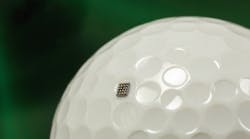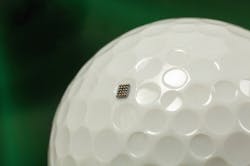How Small A Chip Will A 32-bit Micro Fit In?
At only 1.6 mm by 2 mm, Freescale's latest chip scale package (CSP) is home to a Kinetis KL03 (Fig. 1). This makes it the current size winner for small, 32-bit microcontrollers. The low power system is based on ARM's Cortex-M0+ 32-bit architecture that matches the rest of the Kinetis L family (see “Kinetis L MCUs Include LCD, USB Interfaces”).
Related Articles
- Cortex-M0+ Freedom Modules Support Arduino Shields
- Kinetis L MCUs Include LCD, USB Interfaces
- Suppliers Deliver Low-Cost 32-Bit Arm Architecture
- Who’s Doing What In IoT And M2M?
- 32-Bit Micro Still Handles 5 V For Harsh Environments
The chip scale package has only solder balls between it and the a PCB. Conventional chips have bonding wires and a support structure. This reduces inductance with respect to the die and improves the thermal characteristics of the overall system. Of course, the small size is ideal of wearable devices such as portable healthcare products.
The 48 MHz Kinetis KL03 is no slouch when it comes to features. It has 2 Kbytes of RAM and up to 32 Kbytes of flash storage. The zero-wait state flash is based on Freescale's 90 nm TFS technology.
The chip uses an 8 Kbyte ROM-based boot loader that has the advantage of supporting a low-power boot mode. This can help reduce power spikes when waking up from a deep sleep as well as providing better power utilization especially for power constrained applications that might employ energy harvesting. It also make flash upgrades easier since that support code is in ROM.
The chip has 9 power modes that include various combinations of processor and peripherals being turned on. There is a compute mode were the processor core runs but it cannot access peripherals. Smart, low power peripherals can also be running independently. This approach saves power because the interfaces do not have to be active. Wake up time from a deep sleep takes less than 4 µs.The Kinetis L series has a bit manipulation engine designed to speed embedded applications that need to twiddle bits on a regular basis. The chip supports low power UART, SPI and I2C interfaces at speeds up to 1 Mbit/s. Its timer support can handle basic motor control chores. A peripheral bridge crossbar allows I/O to be connected almost any pin. This can greatly simplify PCB layout.
The microcontroller has a high-speed, 12-bit analog-to-digital converter . The ADC also has an internal 1.2V voltage reference source.
The Kinetis KL03 is available on a number of different development platforms. The $11.99 FRDM-KL03Z joins other Freescale parts on the Freedom platform that is compatible with Arduino shields (see “Cortex-M0+ Freedom Modules Support Arduino Shields”). This provides access to a range of support peripherals. Software support includes Freescale's Code Warrior IDE as well as third party IDEs from Keil, IAR and Atollic that are memory limited but easily handle the Kinetis KL03. Freescale's Processor Export code generator also works with this chip.
The Kinetis KL03 pricing starts at $0.49 with 8 Kbytes of flash memory. Versions are available for -40 °C to +105 °C operation. The CSP version has an operating range of -40 °C to +85 °C. They all support a 1.71 to 3.6 V power supply.


